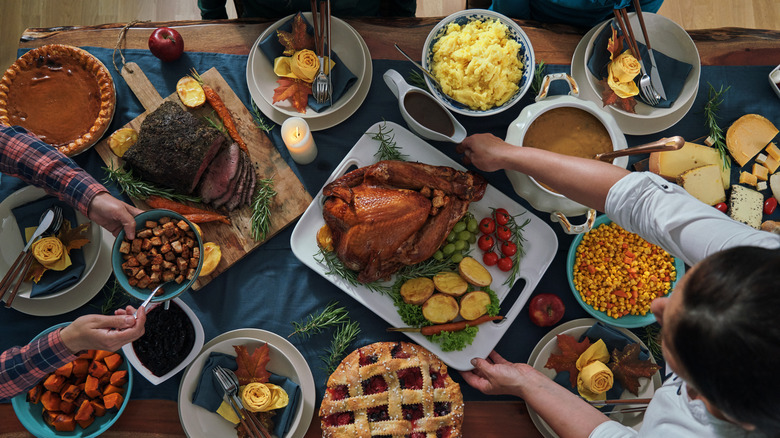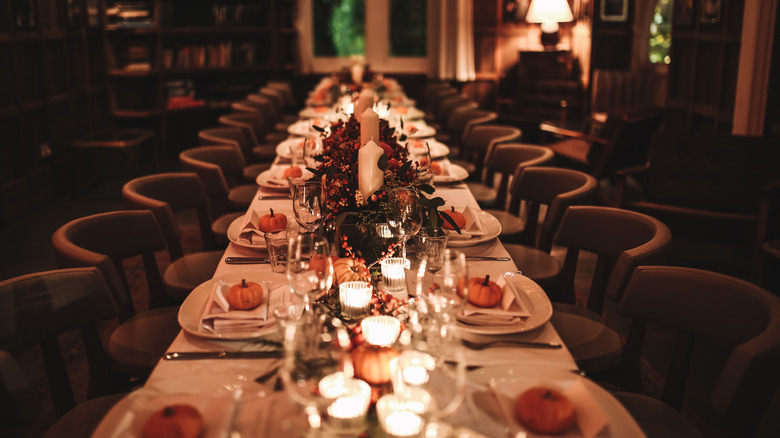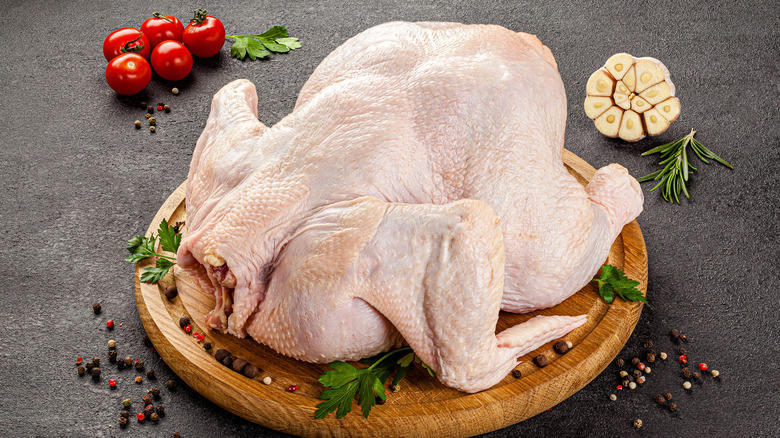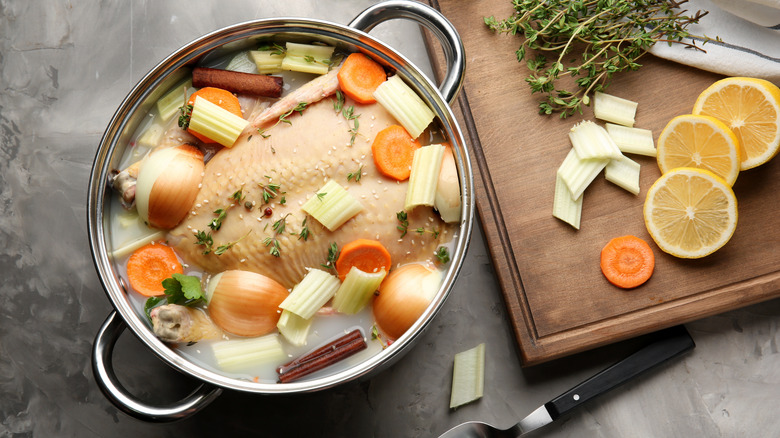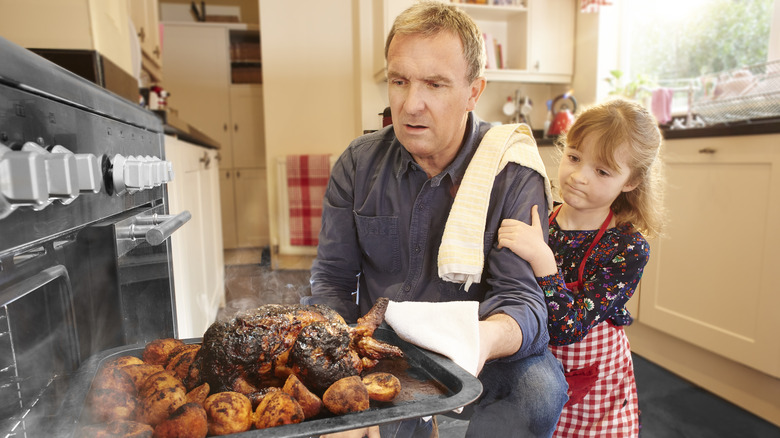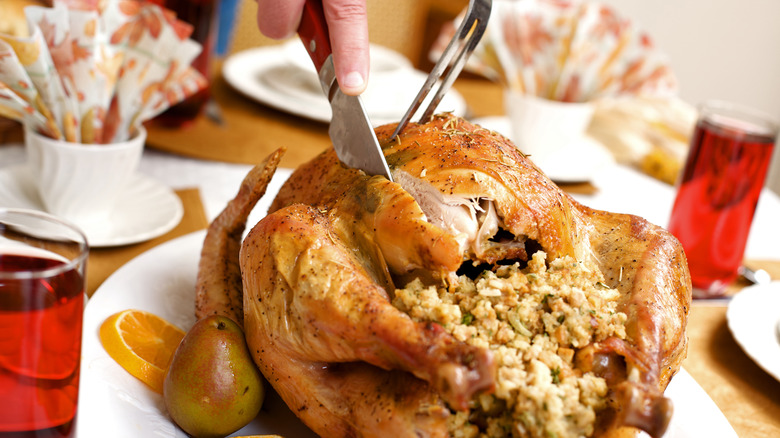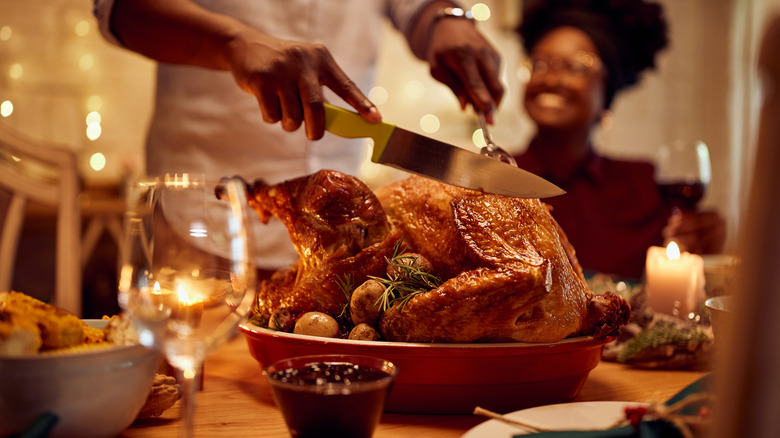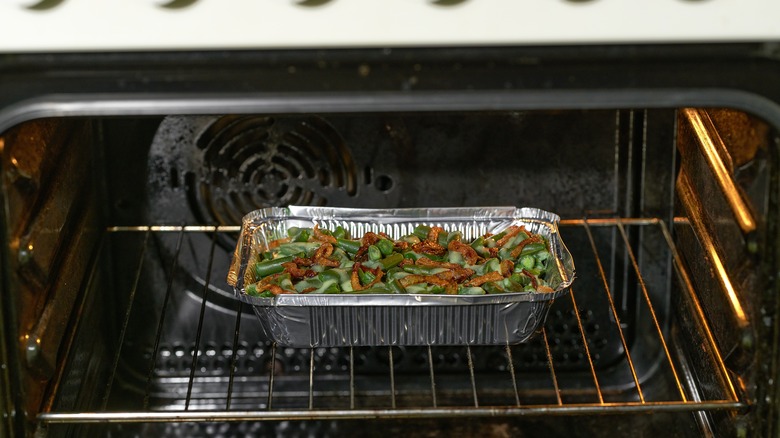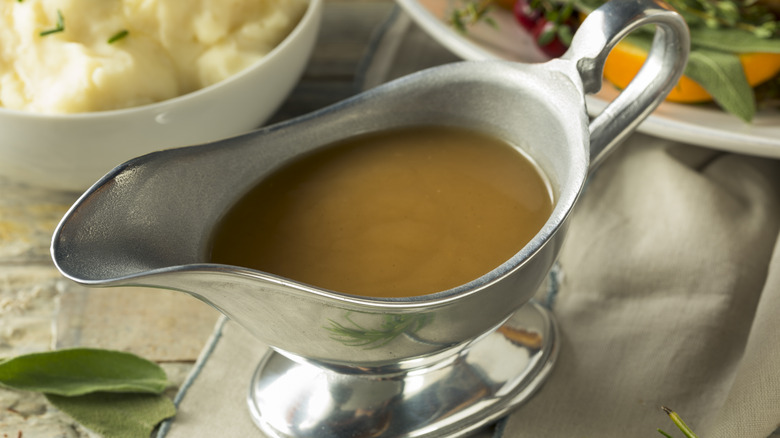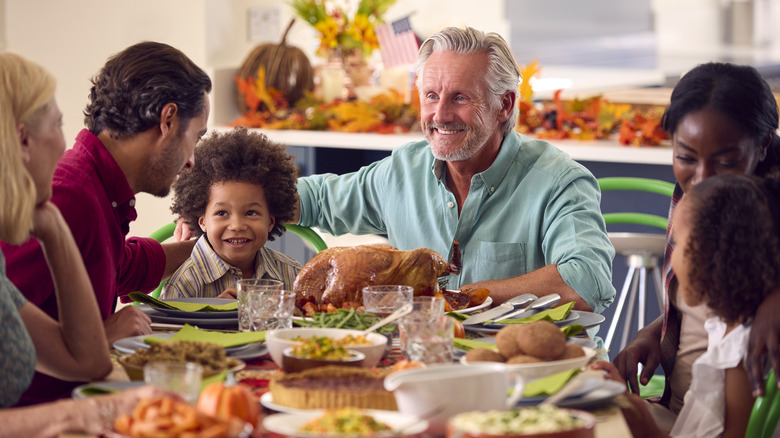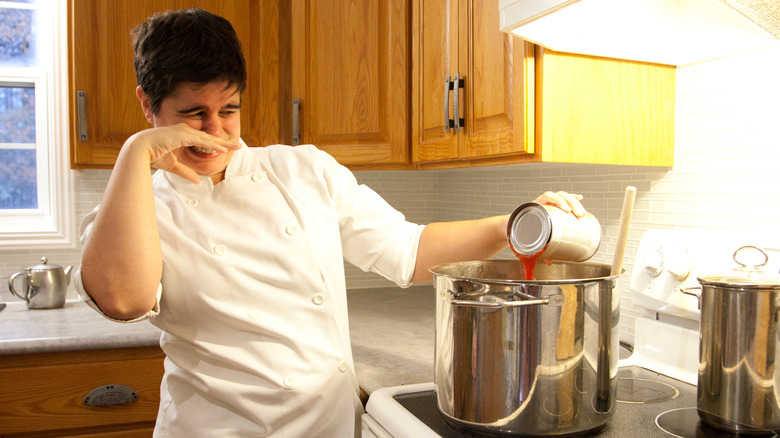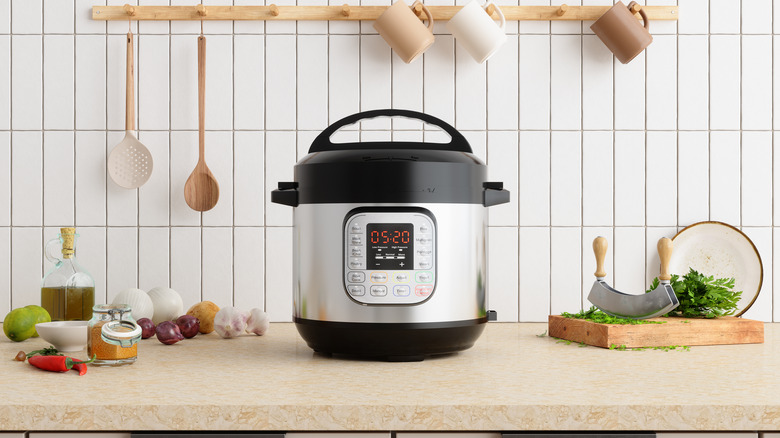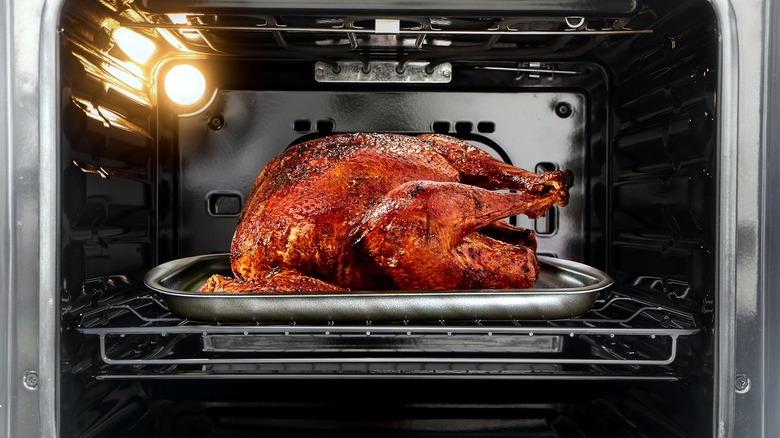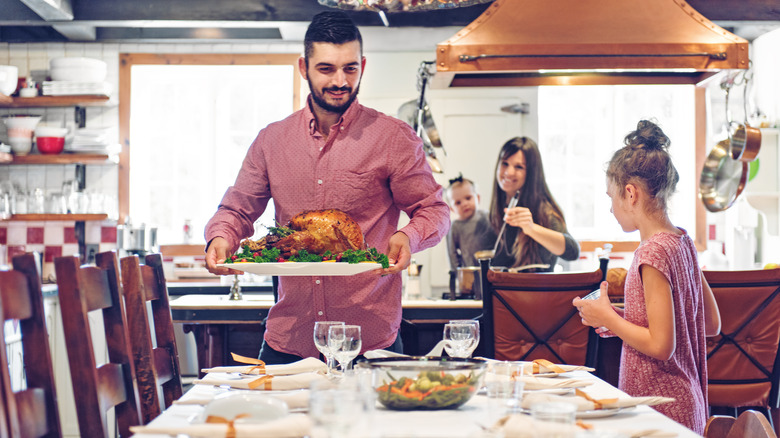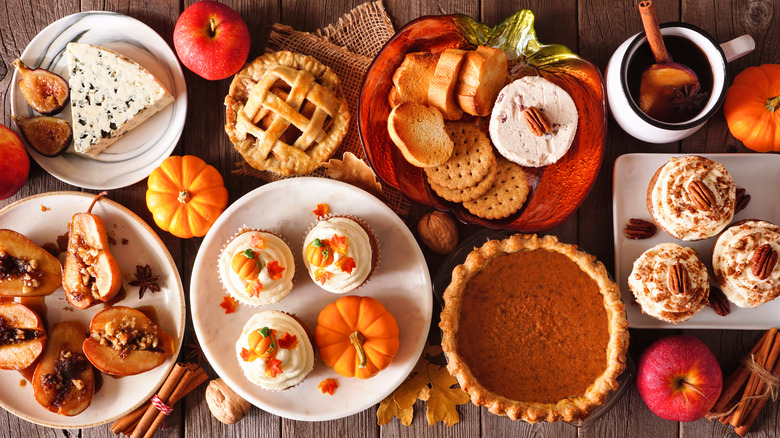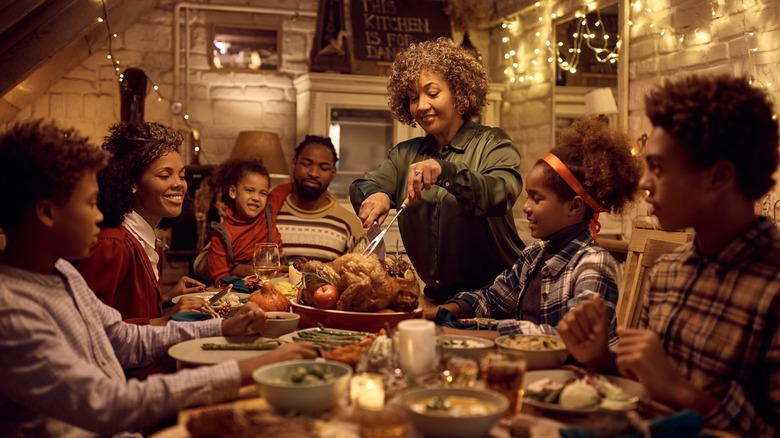16 Mistakes To Avoid When Hosting Thanksgiving Dinner
If you are hosting Thanksgiving dinner this year, you probably already feel the pressure. Whether it is your first time hosting or you have friends and family over every year, there is just so much to do and too many opportunities for disaster. No one wants to serve their guests a burnt or raw turkey, make people wait to eat for hours after the time they intended to serve the meal or feel completely frazzled all day trying to juggle everything that needs to be done.
If you're worried about all of these possible problems — or have a list of several others that are keeping you up at night — take a step back. There are things you can do to make sure that turkey day goes off without a hitch and that your guests leave feeling full and happy. But first, you'll want to start by learning some of the most common mistakes others make when hosting this special holiday meal. This way, you'll have a better idea of what you should — and shouldn't — do when friends and family gather at your house to celebrate everything they're thankful for (which will hopefully include the meal).
1. Not finalizing the headcount at least a week ahead
"Don't put off until tomorrow what you can do today" is a famous quote by Benjamin Franklin. When you're thinking about hosting Thanksgiving, it is excellent advice to keep in mind. You want to get as much done as far ahead of time as possible. Otherwise, you're just setting yourself up for more stress and complications. One of the most important things is to finalize the headcount at least one week before the actual holiday.
Having a final headcount is important for planning how much food you'll need, making sure you have enough seat and place settings, and so much more. You don't want to be waiting on this information as Thanksgiving Day draws near, or you'll be making too many changes to your seating arrangements, grocery lists, and other aspects. To ensure you have an accurate headcount by the week before, send out your invitations at least one month before the big day and set an RSVP date of two weeks before Thanksgiving. This will give you one week to follow up with anyone who doesn't reply to ensure your numbers are firm by the Thursday before Thanksgiving.
2. Leaving all the cooking and prep for Thanksgiving Day
It's a grave mistake to leave all the cooking and prep work for Thanksgiving Day. While there are some dishes that you definitely want to cook right before serving them, there are several that can be made — or at least started – ahead of time. Pies, for instance, are a perfect example of something that can be made at least the night before the big day. They'll be served cold anyway (or heated up right before serving), and don't need to factor into your oven cooking times on the holiday itself. Some other dishes that you can prep ahead of time include casseroles, cranberry sauce, and sweet potato purées. If you're planning to make homemade rolls, get them ready to bake and then freeze the dough. You can pop them in the oven after the turkey comes out and they'll be ready in no time.
In addition to doing some of the cooking ahead of time, there are other tasks that you should make sure you complete ahead of time. Don't leave any cleaning for the day of your party — you're simply not going to have the time to get it done. You can also get the table set the night before, put up any decorations, and get your serving dishes out and ready.
3. Improperly or unsafely defrosting the turkey
Frozen turkeys are often less expensive than their fresh counterparts and can allow you to purchase the bird ahead of time to make sure you're prepared. However, with a frozen turkey, you have to make sure that you defrost it properly. Don't make the mistake of leaving it out on the counter to thaw, as this will warm up some sections faster than others, allowing bacteria to grow. You don't want to inadvertently give your guests food poisoning.
According to the USDA, thawing a turkey in the refrigerator is the safest option. When thawed in a refrigerator, the turkey will defrost evenly, at a safe temperature. However, because turkeys are so large, they'll take much longer to defrost than smaller cuts of meat. Aim to leave about 1 day for every 4 to 5 pounds. So, a 15-pound turkey should defrost in about three to four days, while a 20-pound bird will need a bit longer.
If you forget to move the turkey from the freezer to the fridge, you can also thaw it in cold water. The entire turkey will need to be submerged in order for this method to remain safe, and you'll want to change out the water approximately every 30 minutes to make sure it doesn't get too warm. If you need to use this method, plan for it to take approximately 30 minutes for each pound of meat, so it should take 8 hours to defrost a 16-pound turkey.
4. Overlooking the benefits of brining the turkey
While you can cook a turkey without brining it, you may regret your decision to do so. Brining is a process in which the turkey is soaked in a solution with salt (and often other seasonings), but salt is the key component of a brine. As the turkey soaks in the solution for several hours, the salt works to break down the muscle proteins of the bird. When the turkey is later placed in the oven, it won't contract as much, which should prevent it from losing moisture. One common complaint that many people have about turkey is that it just gets too dried out. Brining is seen as a solution to prevent this problem.
However, there are a few potential downsides to brining that you'll want to weigh before giving it a try this holiday season. First, you'll need to adjust your timeline. Rather than having your turkey defrosted by Thanksgiving morning, it will need to be thawed and ready to go several days in advance. The turkey should sit in the brining solution for several hours (up to 18 for previously thawed birds or up to 36 hours from frozen). Brining can also be logistically complicated, as you'll need a large enough container or pot to hold the turkey and keep it fully submerged in the liquid solution.
5. Under or over cooking the turkey
One of the most disastrous mistakes you could make this Thanksgiving would be to over — or under — cook your turkey. An overcooked turkey is going to be dry and unsalvageable, even with the best gravy. Your guests are not going to enjoy the meal and will be looking for Thanksgiving dinner number two when they get home.
However, as bad as it would be to serve overcooked turkey, serving an undercooked bird would be even worse. Beyond the weird texture that the meat would have, you'd also be serving it up with a side of food poisoning. Bacteria and viruses may still be present in undercooked turkey meat. So, you need to verify that your turkey is finished by checking the temperature with a meat thermometer. Pop-up timers and other signs of "doneness," such as legs that wiggle easily, can help, but they're not always accurate. There are two places where you'll want to check for doneness using your meat thermometer: the thigh and the breast. The internal temperature of the thigh should read at least 180 degrees Fahrenheit, while the breast must be a minimum of 170 degrees Fahrenheit.
6. Cooking stuffing inside the turkey without safety in mind
While it used to be standard practice, you may have noticed that there has been more debate about the safety of cooking stuffing inside a turkey. The USDA explains that the risk of food poisoning is a bit higher when you cook a stuffed turkey compared to when you cook one without stuffing inside of it. However, they still say that it is possible to cook the stuffing inside the bird, so long as users understand the risk and take appropriate measures to mitigate it.
The potential problem lies in the internal temperature of the cooked stuffing. If it doesn't reach at least 165 degrees Fahrenheit before the turkey is removed from the oven, there may still be bacteria present, which could make you or your guests sick. So, if you do want to cook stuffing inside your turkey, you will need to use your thermometer to verify its temperature, not just the temperature of the meat itself. Sometimes, the stuffing may take longer to cook than the actual turkey, which could result in dried-out meat. For this reason, you might decide that you're better off using a separate baking dish to cook the stuffing.
7. Carving the turkey all wrong
Did you know that there is a right way and a wrong way to carve a turkey? Well, there is. And, you don't want to make the mistake of carving your turkey all wrong. Fortunately, it isn't difficult to properly carve a turkey and ensure that you serve beautiful and juicy slices to your guests. Be sure to give the turkey at least 15 minutes to rest after it is removed from the oven so that the juices will settle.
Once you're ready to start carving, position the bird so that the cavity is facing you. Use a sharp knife to cut off the leg and thigh by slicing through the joint. When the knife comes into contact with the bone, you can move the thigh back to help identify exactly where the joint is before cutting more to separate the leg and thigh from the rest of the bird. Repeat with the other side. Cutting off the wings follows a similar process, where you'll want to pull them back to find the joint to slice through with the knife.
Now, you're ready to cut off the turkey breaks. Use your knife to slice along one side of the breastbone and then pull the meat away from it until it is removed. Repeat these steps for the other side of the bird. Finally, make even slices for the breast meat and cut the legs and thighs apart so you can slice them.
8. Not timing the different parts of the meal properly
There are a lot of moving parts involved in pulling off a flawless Thanksgiving dinner. One thing that many people have difficulty with is getting the timing down right. You want everything to be ready to eat at the same time so that nothing gets cold. Following the advice shared above and having cold dishes ready and waiting — such as your cranberry sauce — can help.
Check recipe instructions and cook times and work backward from when you need everything to be ready. For example, if your French onion mashed potatoes will take 45 minutes from start to finish, make sure that they are started no later than 3:10 if you plan to have food on the table at 4:00. Some things will need to be in progress before the turkey is out and ready to finish up quickly as it is resting and being carved.
9. Discarding the drippings
Whatever you do, don't discard the beautiful drippings from your roasting pan after removing the turkey. The drippings can help you make the most scrumptious turkey gravy that will have your guests running back for second helpings of turkey and mashed potatoes just to get a few more tastes of it. To use the drippings for your gravy, start by straining them to remove solid fats and any other chunks of meat.
Then, you'll want to add some flour and gravy mix (if desired) to a saucepan or saucier. If you don't have gravy mix, you can also add some seasonings, such as parsley, thyme, or garlic. One of the tricks to making gravy is to stir it frequently. You want to make sure that there are no lumps in it and that it has the right consistency (pay attention to how much water you add to make sure that you don't thin it out). As you stir, bring the pan to a boil. Then, simmer the gravy for about 5 minutes on a lower heat setting to let it thicken. Be sure to keep stirring periodically while this happens.
10. Failing to make enough food
Another mistake you'll want to avoid at all costs is failing to make enough food for all of your guests. You don't want anyone to leave your house still hungry or make people feel like there isn't enough food to go back for a second helping if they want it. In fact, some of your guests are likely looking to bring some leftovers home to enjoy turkey sandwiches over the coming days.
Aim to have a turkey with the same weight as the number of people you'll be hosting. This means that you should buy a 15-pound bird (or even a bit bigger) if you're hosting 15 people. As far as the side dishes go, you'll need to have a minimum of ½ cup of each option for each of your guests. So, with the same 15 people coming to dinner, you'd need 7.5 cups of sides such as mashed potatoes or green bean casserole. Similarly, for dessert, each of your guests should be able to receive at least one slice of pie (but many people might want to sample different options, so be sure to keep that in mind as well).
11. Experimenting with new recipes for the first time
Trying a new recipe can be exciting. However, Thanksgiving Day is not the right time to try to make something that you've never cooked before. There are just too many variables that could throw off your entire meal. What will you do if the recipe takes longer to cook than expected or doesn't actually taste good? With how perfectly timed everything has to be, and the fact that you'll have guests waiting to be served their meal, there won't be an opportunity to come up with a plan B.
If you've found a new recipe that sounds interesting that you'd like to serve for Thanksgiving, give yourself time to practice it before the big meal. Plan to cook it at least two times for yourself and the others in your household to make sure you're familiar with the steps required for preparing it. Making it a few times beforehand will also give you the opportunity to experiment with any adjustments or substitutions that you think will make it taste better.
12. Not having a plan to keep food warm
No one wants to be served a cold Thanksgiving dinner, or even just a cold lump of mashed potatoes next to other warm items on their plate. For these reasons, it is essential to make a plan for how you'll keep all the food warm until your guests are ready to enjoy it — or for when they're ready to have a second helping. Fortunately, when you take just a little time to think ahead, you can avoid these issues.
There are several ways in which you can ensure that your main dishes and entrees don't get cold this year. For example, chafing dishes use a small burner placed below the metal pan to keep items warm. Another option would be to place items like veggies, stuffing, or mashed potatoes in a slow cooker set to low or keep warm. You could also try placing dishes in the microwave — which is insulated — to keep them warm. You don't need to actually heat them in here, but they won't cool down as quickly if they're put in while they are still warm.
13. Forgetting to think about available oven space
If you're planning a big feast for your loved ones, it is easy to get carried away and plan too many side dishes and desserts to give each guest something to indulge in. However, don't get so carried away that you end up forgetting that the turkey will be consuming a lot of the space in the oven for much of the day. So, unless you're lucky enough to have two ovens, you're going to need to have a well-thought-out action plan in place before the big day. Start by making pies or anything else that can be served cold a day ahead of time. You don't need any of these items consuming precious oven space.
You should also try to be purposeful with your recipe selection. Aim to choose side dishes that bake at the same oven temperature so that you'll be able to put them next to each other. You might need to find the happy middle ground if the oven temperatures aren't exactly the same, but try to avoid a large temperature spread, such as rolls that bake at 325 degrees Fahrenheit and sweet potatoes that you want to roast at 425 degrees Fahrenheit.
You could also get around the problem of limited oven space by letting some of your other kitchen appliances help with the heavy lifting. Look for a few side dishes that you could cook in a microwave, air fryer, slow cooker, or pressure cooker.
14. Trying to do everything yourself
There is no shame in asking for help or accepting an offer of assistance. As you already knew before reading this, and as was probably reinforced over the last few sections, there is a lot to think about when you're hosting Thanksgiving. It is a lot of work — from planning everything out several weeks in advance, cleaning your home, going grocery shopping, decorating, and, of course, doing all the cooking and baking.
Instead of trying to do all of this yourself, enlist some help. Talk with a trusted friend or family member who will be coming to the big meal and ask them to help you with some of the planning and prep work. On the day of Thanksgiving, don't be afraid to ask your guests to pitch in a little. Some could help with bringing the food to the table or the buffet area, while others could help clean up dishes after the meal. Everyone will be happy to help to show their gratitude for the delicious meal you prepared.
15. Forgetting about dessert
Turkey might be the thing that most people first think of when talking about Thanksgiving, but everyone knows that dessert is where it is really at. Whatever you do, don't forget to plan dessert when deciding what you'll serve your guests. Pumpkin pie is a classic, but it isn't all you can offer. Depending on the number of people who will be attending your meal, you might want to have a few different options available, which will also suit different taste buds.
There are several other pie options that you could serve instead of — or in addition to — pumpkin pie. Some of these include apple pie, pecan pie, sweet potato pie, cherry pie, or mincemeat pie. But, you don't have to limit yourself, or your guests, to just pies. Some other delectable ideas include a pumpkin roll, apple turnovers, caramel apples, pumpkin cheesecake, cookies, fruitcake, or brownies.
16. Not enjoying the day
Make sure that you let yourself enjoy the day. It is easy to let the stress get to you and be hard on yourself if something doesn't go exactly to plan, but it is important to remember what Thanksgiving is all about. It is a day when we all come together, share a meal together, and celebrate everything in our life we have to be thankful for. Many things have changed since the first Thanksgiving, but these key tenets remain the same.
Give yourself time to sit at the table and enjoy a conversation. If the dinner portion of the meal draws on a bit longer and your guests have to wait a few additional minutes for their dessert, they'll understand. After all, everyone is gathering together with the same common goal. When you're planning your schedule for the day, be sure to work in a few breaks where you can step away from the stress and take a breather to help yourself refocus on your larger goals.
